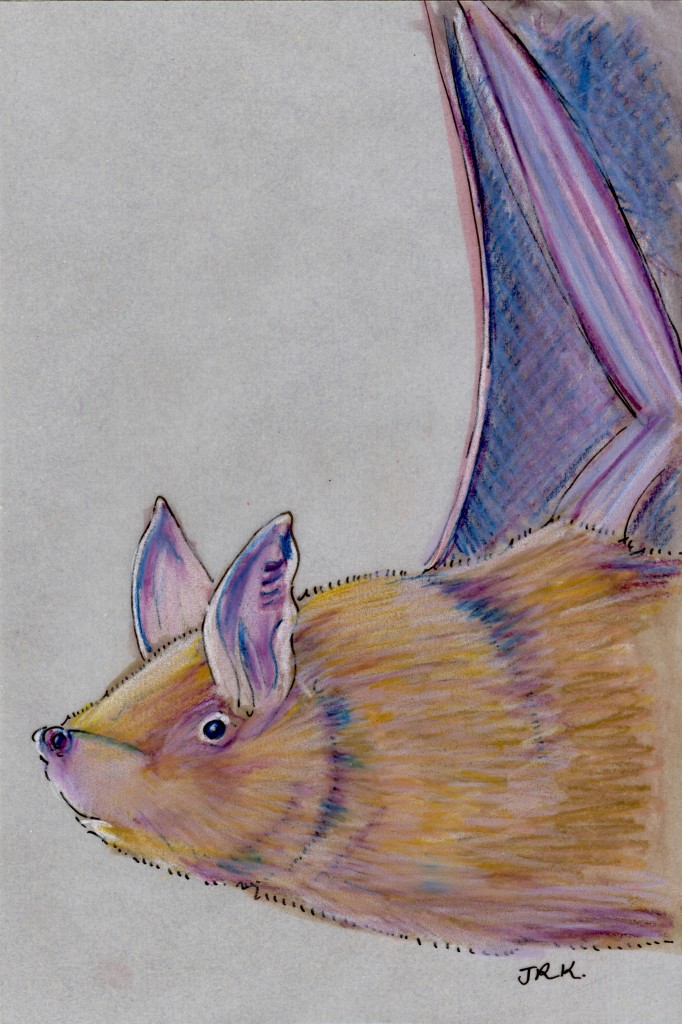World Cup: New Zealand Lesser Short-Tailed Bat (Mystacina tuberculata)
We are continuing our look at the World Cup, and with this particular entry, we have some officiating errors, just as they have in the soccer tournament. You see, I usually draw my bats the way they are usually photographed: maybe hanging upside down, probably crouched on a tree or something. I like drawing portraits, and besides, there aren’t that many great reference photos of flying bats available. But lately I’ve been feeling like I’ve been drawing the same few drawings over and over—the same monkey face, the same carnivore portrait, the same crouching bat—so this time, I decided to take the harder path and draw a flying New Zealand short-tailed bat. I gathered some reference for the particular species and some other reference for bats flying in general and cobbled together this drawing. It turned out okay, not spectacular, but not embarrassing. And then I started researching the species for my write-up.
And found out that this is a bat that doesn’t fly.
One of two species, out of more than 1,000, that can walk on the ground. (The other is the vampire bat, which I have already drawn; it’s all flying bats from here on out.)
And that’s the one I decided to draw flying.
It’s not that it can’t fly—I exaggerated when I said they don’t fly—but it does most of its feeding and foraging on the ground, and as MSNBC.com says, it’s an “odd creature” that “can walk on all fours and doesn’t get easily flustered.” Here’s a video from ARKive:
What’s neat is that it’s a bat that is evolving into a ground animal. That seems like a pretty good idea on an island like New Zealand, where the only mammals arrived there by air—the bats—or by sea—the seals—or else were introduced, like rats and livestock. That leaves a pretty good niche for a little ground mammal that eats insects and grubs, and that’s the niche the lesser short-tailed bat is filling. (Recent discoveries suggest, though, that the bat was already evolving in this direction before it arrived in New Zealand: a fossil found in Australia seems to be an ancestor of the New Zealand bat and is also adapted for walking.)
So let’s just say that this soaring bat is experiencing a special moment in its life, just as the New Zealand soccer team did when it qualified for the 2010 World Cup, only its second qualification in its history (the other was in 1982). And New Zealand was undefeated in this World Cup! But the team’s three draws weren’t enough to get it out of the group stage, and so the All Whites (the country’s rugby team is the All Blacks, and the national basketball team, no fooling, is the Tall Blacks) went back home again.
The All Blacks—New Zealand’s rugby team—are known for doing a traditional Maori dance called a haka before games. I imagine it’s both intimidating to the opponent and energizing to the team. There was some talk of the All Whites doing a version at the World Cup, but as far as I can tell, they never did. So here’s a video of the rugby players’ haka from a game in South Africa.


That is a very interesting post. The guys do look intimidating, and don’t seem to feel a bit silly doing their haka.
A bat that is evolving into a land animal – I wonder when (if) we will ever find specimens of these bats that can’t fly at all.
Well, Grace, I don’t think they should be embarrassed, although I can imagine that you and I might we if we had to do that dance. Animal Annie, that’s a good question. And one that I have no idea of the answer to. Have you read The Beak of the Finch? It’s a very good book about evolution within species and the back-and-forth, rather quick way small changes can happen.